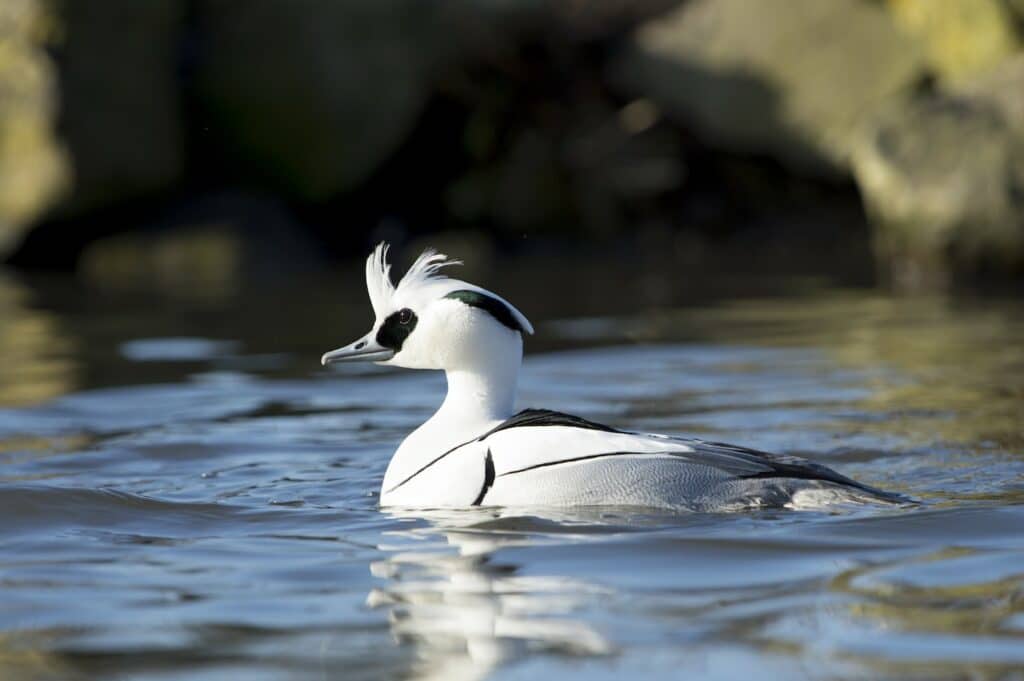The Smew, a captivating species of duck with distinctive plumage, has piqued the interest of ornithologists worldwide. This article delves into the unique physical traits, habitat, and migration patterns of the Smew. Further, we explore the species’ dietary habits, reproductive cycle, and current conservation status. This comprehensive overview will provide valuable insights into the captivating world of the Smew, contributing to ongoing studies and conservation efforts.
The Unique Physical Characteristics of the Smew
The Smew, a unique species of duck, boasts a distinct set of physical characteristics that sets it apart from other members of the Anatidae family. One of the significant Smew adaptations is its streamlined body and pointed wings, which augment its agility and speed in flight. Its striking colour variations, predominantly white with black markings, are more than just aesthetically pleasing. These colours serve as an effective camouflage, blending in with the snowy landscapes of its natural habitats. The male Smew, known for its crisp black-and-white pattern, stands in contrast to the more subtly coloured female. These physical attributes not only aid in survival but also contribute to the Smew’s reputation as a visually captivating species.

Habitat and Migration Patterns
Navigating through vast geographical territories and adapting to diverse climates, the Smew’s habitat and migration patterns present a fascinating study in avian resilience and adaptability. These birds predominantly dwell in the northern taiga forests, near bodies of water. Smew adaptations to this habitat include a robust immune system, and a compact, streamlined body for efficient flight and diving.
The Smew’s lifespan, averaging a decade, is marked by regular migration. Each winter, they journey southwards to temperate regions, fleeing the harsh Arctic cold. This migration showcases their remarkable stamina and navigational abilities. However, their habitats are threatened by climate change and deforestation, posing challenges to their survival. Understanding these patterns and threats is crucial for effective Smew conservation.
The Smew’s Diet and Predatory Behaviour
Primarily feeding on a diet of small fish and aquatic invertebrates, the Smew exhibits an intriguing mix of predatory behaviour and dietary preferences that reflect its adaptation to aquatic environments. One of the key Smew adaptations is its knack for diving and swiftly swimming in water to catch prey. Its slender body and streamlined shape facilitate efficient Aquatic Prey Hunting. The Smew uses its sharp beak to catch and hold onto its slippery prey, demonstrating the bird’s specialized feeding strategy. This diet not only provides the Smew with essential nutrients but also influences its migratory patterns, as this species tends to move towards areas abundant in its preferred food sources. Overall, the Smew’s dietary habits and predatory behaviour exhibit a fascinating interplay of adaptation and survival strategies.
Mating Rituals and Reproduction Cycle
Often, Smews engage in complex mating rituals, and their reproductive cycle is a fascinating blend of courtship displays, nesting, and parental care. Central to these rituals is the male Smew’s distinctive ‘head-throwing’ performance, which serves as a potent emblem of Smew symbolism in various cultures. This display, often depicted in folklore, signifies strength and determination. During nesting, the female chooses a secluded spot, usually a tree hollow, reflecting the Smew’s affinity with both water and woodland. After laying eggs, both parents participate in their care, embodying nurturing qualities also associated with Smew in folklore. Their reproduction cycle is thus not only intriguing for its biological complexity but also for the rich cultural symbolism it represents.
Conservation Status: Threats and Measures to Protect the Smew
Despite its wide distribution across Eurasia and North America, the Smew faces a number of serious threats that have led to its classification as a species of ‘Least Concern’ on the International Union for Conservation of Nature (IUCN) Red List. Smew population trends indicate a decline in numbers due to habitat loss, pollution, and climate change. Smew human interactions, particularly hunting and disturbance, have also contributed to this decrease. To mitigate these threats, measures are being implemented to protect the Smew. These include enforcing hunting regulations, preserving their habitats, and implementing climate change mitigation strategies. Public awareness campaigns are also critical to ensure that human interactions with these birds are managed in a way that supports their survival.
Conclusion
In conclusion, the Smew, with its distinctive physical characteristics, exhibits unique habits in terms of migration, diet, and reproduction. Despite facing threats due to habitat loss and climate change, measures are being taken to conserve this remarkable species. Continued research and conservation efforts are crucial to ensure the survival and prosperity of the Smew in its natural habitats. Understanding the Smew’s behaviours and life cycle can provide valuable insights into its role in the ecosystem.
Sam loves to learn about animals and their habitats. He has been a nature lover from a very young age, and has been writing papers and articles about wildlife for as long as he can remember.
